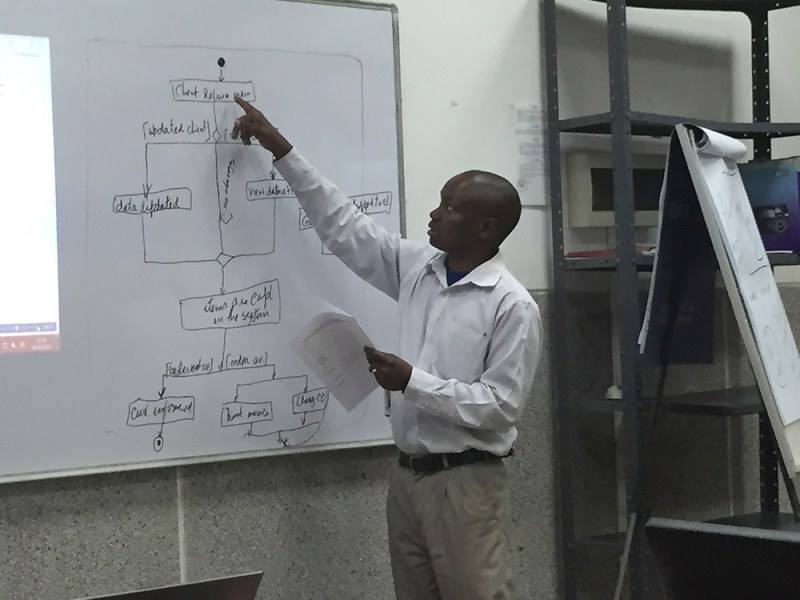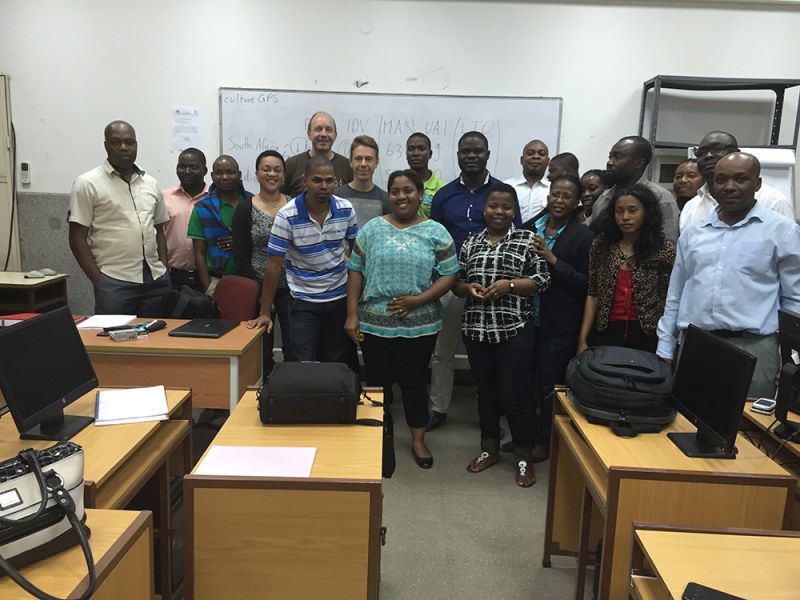Introduction
In January 2015, we received a call from a colleague asking if we would be interested in running a requirements engineering workshop in Maputo – Mozambique. We just knew that the country is somewhere in Africa, since we have never heard anything in the news. We barely recalled that the country was facing a long lasting civil war in the 1990s. So before we finally decided to accept, we performed some research about Mozambique, starting with the CIA world fact book [1], which we can recommend as a good source for research on other countries / regions.

We learned that Mozambique used to be a Portuguese colony until 1975, and that the country’s development was slowed down due to a severe drought in the 1990s and a long lasting civil war which ended in the mid-1990s (CIA, 2015). In addition to that the country has to deal with Malaria, a high rate of HIV positive citizens and many other problems you may expect for many sub-Saharan African countries. So the overall environment seemed to be very adventurous and from the descriptions it didn’t sound like traveling to a vacation spot. The educational system is not very well developed and more than 40% of the overall population is illiterate (CIA, 2015).
The DAAD (German Academic Exchange Service), together with the Federal Ministry of Education and research (Germany) and the University of Oldenburg, have initiated a program to support some sub-Saharan countries such as Ghana, Tanzania and Mozambique. The project is coordinated by Professor Jorge Marx Gomez from the University of Oldenburg, Germany [2]. In addition we were able to attract IREB to support the class within their IREB Academy Program IREB Academy Program, since the development of the academic workshop was based on the CPRE foundation level syllabus. Due to this fact the experiences from this workshop will contribute to the improvement of systems and software engineering and have a practical relevance for the internationalization of the CPRE-Content and syllabus. Before discussing the experiences on site the educational system needs to be explained a bit more.
The educational System in Mozambique
The Educational System in Mozambique is, due to the influences while being a Portuguese colony, similar to many Western education systems. It can be divided into four main areas: ‘primary education’, 'middle education', 'secondary education' and university-based 'higher education'. [3] The age of entry to primary school is 6 years and when finishing school students are usually around 19 years old. But even though it is compulsory, not all the children attend school for various reasons, such as having to work at young age to earn money for the family. Remember that Mozambique is still one of the 10 poorest countries.

As in Western Countries the school system follows a so called 'general curriculum' which guides the teaching topics to be covered in school. At the end of their 12th school year students have to pass a so called 'pre-university exam' for the admission to the bachelor's degree program at university level. Once they have passed this exam they may apply at one of the 15 universities in Mozambique. Nine of these are privately run Universities which charge a monthly fee to the students. The university we performed the workshop at (Universidade Pedagógica of Maputo) is one of those privately run universities in Mozambique. The students have to pay a monthly fee of about 100 Euro to take part in the Master level programs.
The school graduation rates in Mozambique are very low; alone the completion rate in primary schools was between 2005-2009 only 49%, whereas in Germany the completion rate in the same years was at 98%. [4] This does not take into account the approximately 12% of children which did not even attend primary school and therefore didn't receive any kind of education. Compared to the secondary completion rate this is still quite high, as this rate lies at 2% of all educational attainments at the age of 15-24. [5] This has a dramatic impact on the society as the literacy rate among the population is quite low. From the whole population at the age of 15+ the rate for men lies at 73% and for women at only 45%. [6]
The requirements engineering workshop
The requirements engineering class was part of the Environmental Management of Information Systems (EMIS) program, which is a new master level course for students who aim to work in the field of environmental projects where sophisticated IT skills are required. The program was held for the first time in Maputo, and it is planned to perform the course at two other partnering universities in Tanzania and Ghana in 2016. [7] So there is a strong potential for a structured requirements engineering education in the future. Due to this fact assistant professors from these universities also joined the course to see what potential the course and the program has.
The requirements engineering class with 18 students was planned as one block in a single week. The seminar started each day at 16:00 and ended at 21:00 in the evening.. The lecture was conducted as a team where Lars focused on teaching and Henrik did some parts of the class and supported the in-class assignments and group work sessions. In addition to that Henrik translated most of the seminar slides from German to English.
As we were not sure about potential communication problems during the classroom work, as Portuguese is the primary language in Mozambique, we were quite surprised how well it worked to have the seminar in English. The main line of inquiry for the course was based on the IREB CPRE foundation level syllabus. Some content was added to the course based on the special interests of the group, e.g. agile methods were discussed in the context of requirements engineering, and another part was added about the challenges for the requirements specification, if you work with user stories instead of sophisticated requirements specification documents.

We started the first session on Monday with the typical RE start by explaining context boundaries, the grey zone and fundamental UML-Elements such as the use-case analysis. After that we did our first assignment and split the group into five working groups. These groups had to jointly work on the assignments. After the group work phase the results were presented by one or two participants to the audience. Since most students had a strong background with information systems either in their undergraduate study or during the EMIS master courses, it seemed that this part worked smoothly. The only observable issue was that the in-group communication often was in Portuguese and the discussion results had to be translated into English before starting with the presentations. Especially the specific requirements engineering terms had to be explained within the group, so that all participants were able to work on the assignments. This took a little bit more time than expected, but looking at the quality of the results it worked out very well.
The next days we worked our way through requirements elicitation and management, additional UML models such as activity diagrams, class models, package diagrams and sequence diagrams. Furthermore we had a good discussion about how to manage intercultural teams, and which difficulties there are with requirements engineering if you work with a diverse or virtual team setup. Based on our personal experiences during this course, the students were involved most actively during the topics on how to explain use-case diagrams by using UML activity diagrams and the use-case-templates. In contrast to German students, who are often distracted by their mobile devices, the students of this course strongly focused on the taught content and followed the seminar with the highest attention. Another difference was that we often had discussions regarding specific terms and words and the students were asking for an exact definition. This again is a major difference to German classes, where most of the time the course participants are relaxed when it comes to definitions. They more or less aim to understand the big picture. Furthermore there was a strong interest in the different analytical approaches (waterfall versus agile) and how agile requirements management will change software engineering for the next years. During the course we often asked if the pace of the seminar is either too slow or too fast, and most of the time the class responded that it was good and understandable. Even if we asked questions in between to see if the content was really understood, the answers clearly showed that the class was following the workshop. So we may conclude that after an intensive week the students had gained a comprehensive understanding of requirements engineering fundamentals.
To highlight some major differences and learning from this workshop we can summarize:
- The students have a strong focus on the classroom discussion and are disciplined in the application of what was learned.
- The learning process was slowed down, since the lecturers and the participants were using English as a “lingua franca” to communicate. More time was required in class to clarify terms and expressions.
- Learning and teaching with intercultural groups is very motivating and we can take back a great experience from having lectured in Maputo.

Summary and outlook from the IREB perspective
The workshop in Maputo clearly showed that there is a strong potential and more need for education in requirements engineering. The African continent is significantly growing and there is more need to support local universities with requirements engineering knowledge. So with IREB’s increasing internationalization, a cooperation with other universities and educational institutions in Africa seems desirable from our point of view. Especially at the beginning the effort is high, but in the long run many good collaborations may originate from these activities.

- [1] Vgl. CIA world fact book (2015)
- [2] Vgl. Emis sub-sahara program (2015)
- [3] Vgl. American Embassy (2015)
- [4] Vgl. Worldbank (2015) Website
- [5] Vgl. www.classbase.com/ (2015)
- [6] Vgl. CIA (2015)
- [7] Vgl. Emis sub-sahara program (2015)
References and Literature
- [a] American Embassy in Maputo (2015) Website: www.bibl.u-szeged.hu/oseas_adsec/mozambique.htm accessed 25th Septemer 2015
- [b] Baumann (2015). The images were made by Henrik and Lars Baumann while on campus
- [c] CIA (2015). CIA World book of facts. Website: https://essayservice.com/research/the-world-factbook
- [d] Classbase.com (2015) Website: www.classbase.com/countries/Mozambique/Education-System/ accessed 25th September 2015
- [e] Emis sub-sahara program (2015) description: www.emissubsahara.org/ accessed 14th October 2015
- [f] Worldbank (2015) Website: www.data.worldbank.org/indicator/SE.PRM.CMPT.ZS/ accessed 25th September 2015







































































































































